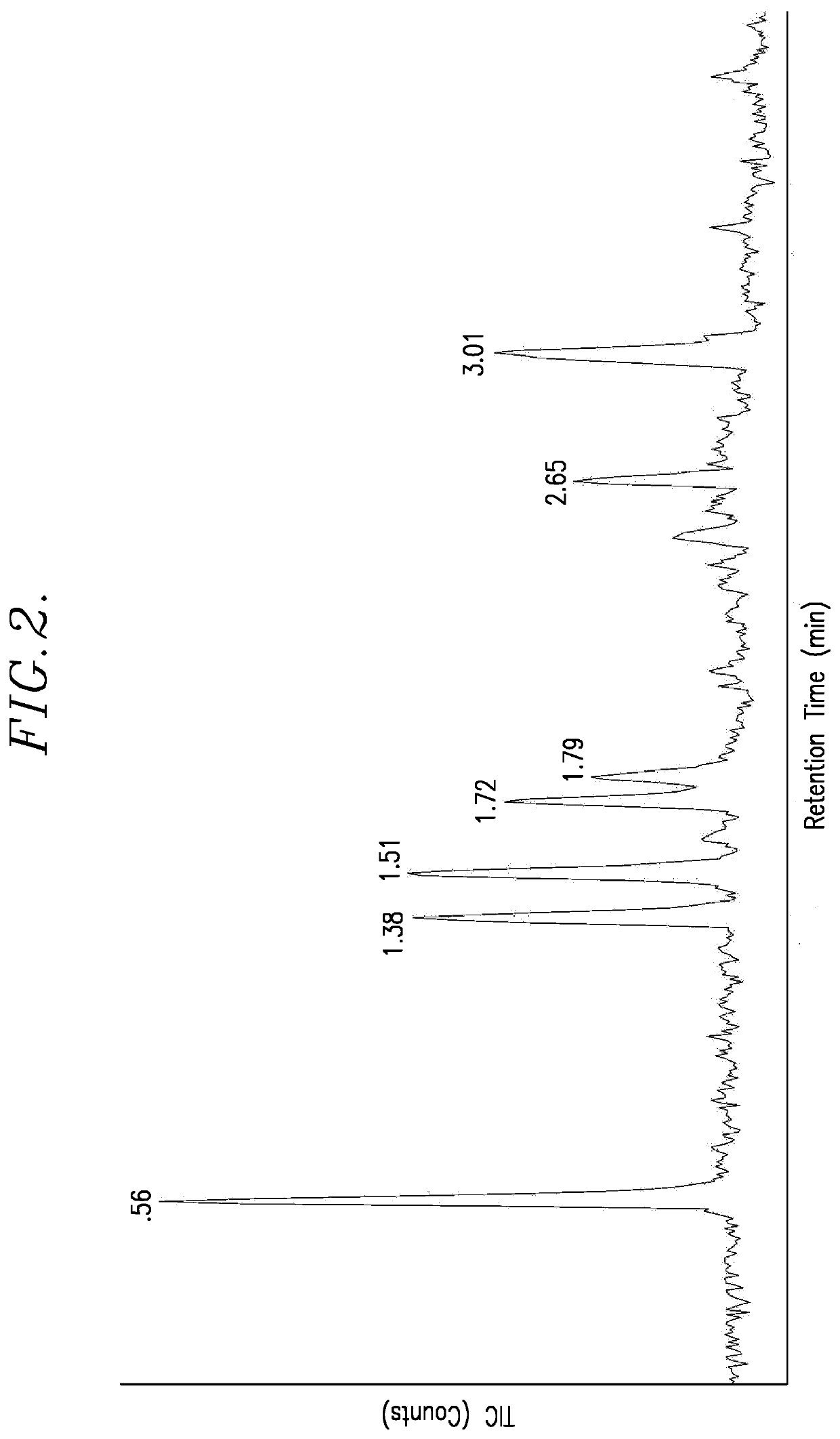Low-temperature synthesis of thymoquinone and harmaline compounds
a synthesis and low-temperature technology, applied in the field of thymoquinone/harmaline adducts or compounds, can solve the problems of high molecular weight species and low yield of desirable reaction products, and achieve good yield effects
- Summary
- Abstract
- Description
- Claims
- Application Information
AI Technical Summary
Benefits of technology
Problems solved by technology
Method used
Image
Examples
example 1
[0029] 1:2-80° C.
A. Ingredients
[0030]164 mg thymoquinone[0031]107 mg harmaline[0032]2 mL EtOH
[0033]1. Combine thymoquinone, harmaline, and ethanol[0034]2. Mix until dissolved[0035]3. Put in −80° C. freezer over the weekend[0036]4. Remove from freezer and allow sample to return to room temperature[0037]5. Add 5 μL of sample to 1 mL of EtOH, with mixing[0038]6. Add 10 μL of dilution to 0.75 mL LCMS grade water and 0.25 mL of LCMS grade acetonitrile
LCMS column gradient:Solvent AWater with 1% Formic AcidSolvent BAcetonitrile with 1% Formic AcidTime (min)Flow (mL / min)% A% B00.7802090.7298100.7298120.78020
[0039]FIG. 1 is the spectrum generated in this example. The following table lists the retention times, the areas under the important peaks, the % areas, and the mass of the corresponding reaction products.
Retention Time (min)Area% AreaMass0.583662172925.502141.3368930084.803781.421993264813.883781.542986611420.803781.6454795883.823781.761895090913.203601.84165421991...
example 2
[0040] 1:2-80° C.
A. Ingredients
[0041]164 mg thymoquinone[0042]107 mg harmaline[0043]2 mL EtOH
[0044]1. Combine thymoquinone, harmaline, and ethanol[0045]2. Mix until dissolved[0046]3. Put in −80° C. freezer over the weekend[0047]4. Remove from freezer and allow sample to return to room temperature[0048]5. Add 2 mL of water[0049]6. Filter using Whatman 1 filter paper[0050]7. Wash with water[0051]8. Dry in oven at 90° C.[0052]9. Add 2 μg of sample to 1 mL of EtOH, with mixing[0053]10. Add 10 μL of dilution to 0.75 mL LCMS grade water and 0.25 mL of LCMS grade acetonitrile
LCMS column gradient:Solvent AWater with 1% Formic AcidSolvent BAcetonitrile with 1% Formic AcidTime (min)Flow (mL / min)% A% B00.7802090.7298100.7298120.78020
[0054]FIG. 2 is the spectrum generated in this example. The following table lists the retention times, the areas under the important peaks, the % areas, and the mass of the corresponding reaction products.
Retention Time (min)Area% AreaMass0.56...
example 4
[0066] 1:3-40° C.
A. Ingredients
[0067]164 mg thymoquinone[0068]71 mg harmaline[0069]2 mL EtOH
[0070]1. Combine thymoquinone, harmaline, and ethanol[0071]2. Mix until dissolved[0072]3. Put in −40° C. freezer overnight[0073]4. Remove from freezer and allow sample to return to room temperature[0074]5. Add 5 μL of sample to 1 mL of EtOH, with mixing[0075]6. Add 10 μL of dilution to 0.75 mL LCMS grade water and 0.25 mL of LCMS grade acetonitrile
LCMS column gradient:Solvent AWater with 1% Formic AcidSolvent BAcetonitrile with 1% Formic AcidTime (min)Flow (mL / min)% A% B00.7802090.7298100.7298120.78020
[0076]FIG. 4 is the spectrum generated in this example. The following table lists the retention times, the areas under the important peaks, the % areas, and the mass of the corresponding reaction products.
Retention Time (min)Area% AreaMass0.594003408128.572140.6396097666.862121.351801635212.863781.43138678469.903781.562494440217.803781.77136578189.753601.86119763338.553763....
PUM
| Property | Measurement | Unit |
|---|---|---|
| temperature | aaaaa | aaaaa |
| temperature | aaaaa | aaaaa |
| temperature | aaaaa | aaaaa |
Abstract
Description
Claims
Application Information
 Login to View More
Login to View More - R&D
- Intellectual Property
- Life Sciences
- Materials
- Tech Scout
- Unparalleled Data Quality
- Higher Quality Content
- 60% Fewer Hallucinations
Browse by: Latest US Patents, China's latest patents, Technical Efficacy Thesaurus, Application Domain, Technology Topic, Popular Technical Reports.
© 2025 PatSnap. All rights reserved.Legal|Privacy policy|Modern Slavery Act Transparency Statement|Sitemap|About US| Contact US: help@patsnap.com



